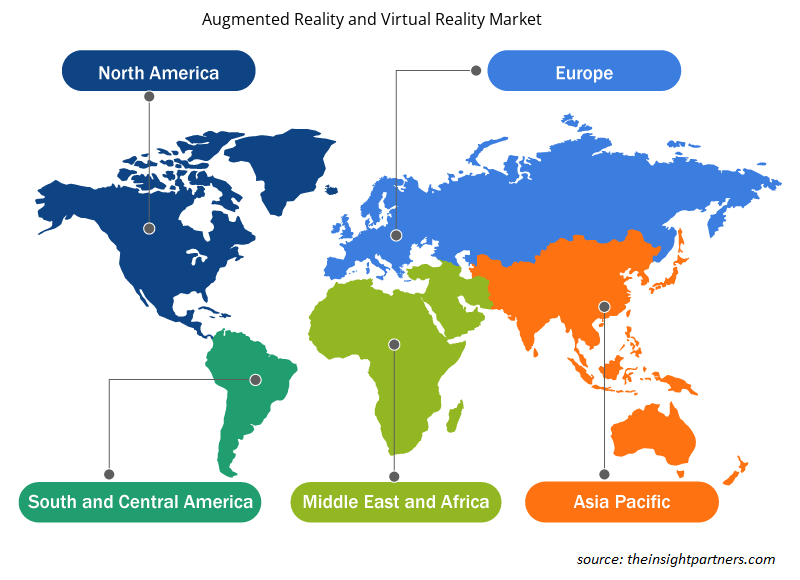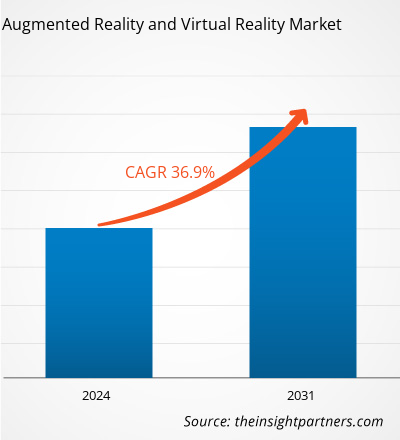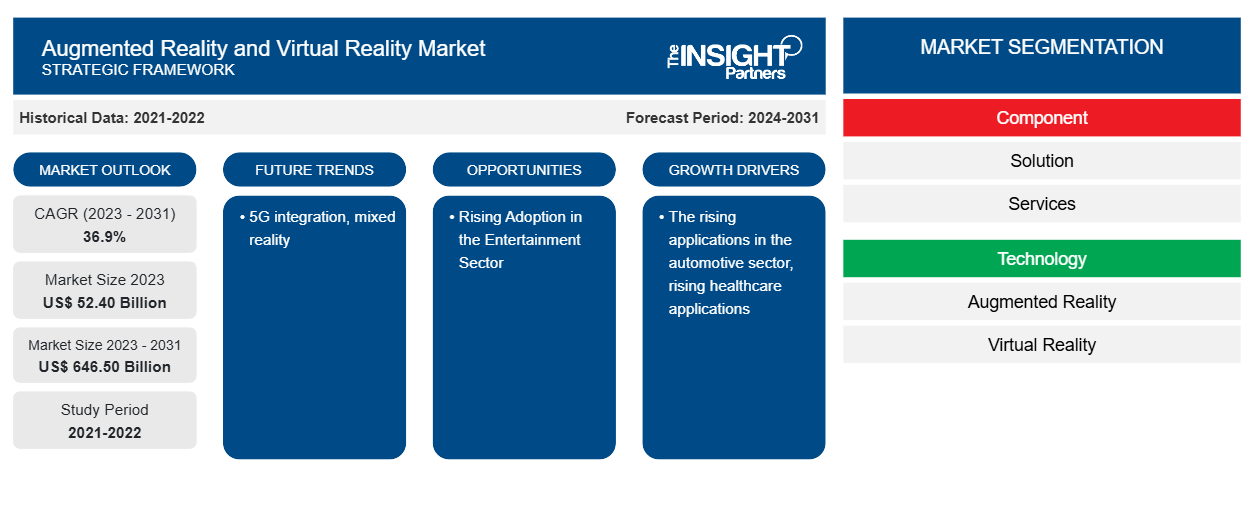Das Marktvolumen für Augmented Reality und Virtual Reality soll von 52,40 Milliarden US-Dollar im Jahr 2023 auf 646,50 Milliarden US-Dollar im Jahr 2031 anwachsen. Für den Zeitraum 2023–2031 wird ein durchschnittliches jährliches Wachstum von 36,9 % erwartet. 5G-Integration und Mixed Reality dürften weiterhin wichtige Trends auf dem Markt bleiben.
Augmented Reality und Virtual Reality Marktanalyse
AR- und VR-Technologie bieten zahlreiche einzigartige Möglichkeiten für neue und etablierte Unternehmen und den Handel. AR-Technologie ermöglicht es Menschen in zahlreichen Berufen, computergenerierte Grafiken in ihrem Sichtfeld zu sehen. Beide Technologien werden in zahlreichen Branchen eingesetzt, darunter Gesundheitswesen, Medien, Gas und Öl, Tourismus, Bildung, Gaming, Unterhaltung, Militär, Marketing, E-Commerce und Einzelhandel.
Augmented Reality und Virtual Reality Marktübersicht
Die globale AR- und VR-Branche erlebt aufgrund der gestiegenen Nachfrage nach Mobilgeräten und F&E-Investitionen ein rasantes Wachstum. Aufgrund der hohen Kosten und der visuellen Wirkung ist die AR/VR-Technologie im Vergleich zu anderen Verbrauchergeräten nur schwach gefragt und wird kaum angenommen. Führende multinationale Technologieunternehmen investieren in VR/AR-Forschung und -Entwicklung, um die Technologie voranzutreiben.
Passen Sie diesen Bericht Ihren Anforderungen an
Sie erhalten kostenlos individuelle Anpassungen an jedem Bericht, einschließlich Teilen dieses Berichts oder einer Analyse auf Länderebene, eines Excel-Datenpakets sowie tolle Angebote und Rabatte für Start-ups und Universitäten.
-
Holen Sie sich die wichtigsten Markttrends aus diesem Bericht.Dieses KOSTENLOSE Beispiel umfasst eine Datenanalyse von Markttrends bis hin zu Schätzungen und Prognosen.
Treiber und Chancen auf dem Augmented Reality- und Virtual Reality-Markt
Die steigenden Anwendungen im Automobilsektor begünstigen den Markt
AR/VR wird in der Automobilindustrie aufgrund der zahlreichen Anwendungen und Vorteile, die es bietet, zunehmend zum Standard. Es vereinfacht und verbessert den Fahrzeugkauf und das Fahrerlebnis für alle Beteiligten. Die Automobilindustrie setzt AR/VR aggressiv ein, um das Fahr- und Urlaubserlebnis zu verbessern. Tatsächlich hat der Automobilsektor von allen großen Sektoren am meisten in AR- und VR-Technologien investiert. Einige Schwergewichte der Branche wie Porsche, Chrysler, Hyundai, Mitsubishi und Tesla haben die beiden Technologien bereits in verschiedene Phasen der Fahrzeugproduktion, des Marketings und des Verkaufs integriert. Dies treibt die Nachfrage auf dem Markt für Augmented Reality und Virtual Reality an.
Steigende Akzeptanz im Unterhaltungssektor
Der Virtual-Reality-Unterhaltungssektor hat die Art und Weise, wie Verbraucher Medien konsumieren, erheblich beeinflusst und einen Paradigmenwechsel in allen Bereichen ausgelöst, von Videospielen über Filme und Live-Shows bis hin zu Erlebnissen in Vergnügungsparks. Die VR/AR-Technologie (Virtual Reality/Augmented Reality) beginnt bereits, sich auf Rundfunk- und Streaming-Medien auszuwirken. VR/AR-Rundfunk und -Streaming können den Zuschauern ein vollständig immersives Erlebnis bieten und ihnen ermöglichen, auf neue und faszinierende Weise mit dem Material zu interagieren. Diese Technologie kann genutzt werden, um fesselnde Erlebnisse wie 360-Grad-Filme, interaktive Sportübertragungen, Virtual-Reality-Musikveranstaltungen und vieles mehr zu produzieren.
Augmented Reality und Virtual Reality Marktbericht Segmentierungsanalyse
Wichtige Segmente, die zur Ableitung der Marktanalyse für Augmented Reality und Virtual Reality beigetragen haben, sind die Technologie-, Komponenten- und Endbenutzerindustrie.
- Basierend auf der Technologie ist der Augmented-Reality- und Virtual-Reality-Markt in Augmented Reality und Virtual Reality unterteilt. Das Augmented-Reality-Segment hatte im Jahr 2023 einen größeren Marktanteil.
- Nach Komponenten ist der Markt in direkte Halbleiterkomponenten, Sensoren und Sonstiges segmentiert.
- Nach Endverbraucherbranche ist der Markt in die Bereiche Unterhaltung, Bildung, Industrie, Medizin, Immobilien und Architektur, Einzelhandel, Luft- und Raumfahrt und Verteidigung und Sonstige unterteilt.
Augmented Reality und Virtual Reality Marktanteilsanalyse nach Geografie
Der geografische Umfang des Marktberichts für Augmented Reality und Virtual Reality ist hauptsächlich in fünf Regionen unterteilt: Nordamerika, Asien-Pazifik, Europa, Naher Osten und Afrika sowie Süd- und Mittelamerika.
Nordamerika dominierte 2023 den Marktanteil im Bereich Augmented Reality und Virtual Reality. Die Region umfasst Länder wie die USA und Kanada, die technologisch weit fortgeschritten sind. Die Startup-Landschaft in den USA entwickelt sich kontinuierlich weiter, wobei aufstrebende Akteure Durchbrüche bei hochmodernen AR- und VR-Technologien erzielen.
Regionale Einblicke in den Augmented Reality- und Virtual Reality-Markt
Die regionalen Trends und Faktoren, die den Augmented Reality- und Virtual Reality-Markt während des Prognosezeitraums beeinflussen, wurden von den Analysten von Insight Partners ausführlich erläutert. In diesem Abschnitt werden auch Augmented Reality- und Virtual Reality-Marktsegmente und die Geografie in Nordamerika, Europa, im asiatisch-pazifischen Raum, im Nahen Osten und Afrika sowie in Süd- und Mittelamerika erörtert.

- Erhalten Sie regionale Daten zum Augmented Reality- und Virtual Reality-Markt
Umfang des Marktberichts zu Augmented Reality und Virtual Reality
| Berichtsattribut | Details |
|---|---|
| Marktgröße im Jahr 2023 | 52,40 Milliarden US-Dollar |
| Marktgröße bis 2031 | 646,50 Milliarden US-Dollar |
| Globale CAGR (2023 - 2031) | 36,9 % |
| Historische Daten | 2021-2022 |
| Prognosezeitraum | 2024–2031 |
| Abgedeckte Segmente |
Nach Komponente
|
| Abgedeckte Regionen und Länder |
Nordamerika
|
| Marktführer und wichtige Unternehmensprofile |
|
Dichte der Marktteilnehmer für Augmented Reality und Virtual Reality: Die Auswirkungen auf die Geschäftsdynamik verstehen
Der Markt für Augmented Reality und Virtual Reality wächst rasant. Die Nachfrage der Endnutzer steigt aufgrund von Faktoren wie sich entwickelnden Verbraucherpräferenzen, technologischen Fortschritten und einem größeren Bewusstsein für die Vorteile des Produkts. Mit der steigenden Nachfrage erweitern Unternehmen ihr Angebot, entwickeln Innovationen, um die Bedürfnisse der Verbraucher zu erfüllen, und nutzen neue Trends, was das Marktwachstum weiter ankurbelt.
Die Marktteilnehmerdichte bezieht sich auf die Verteilung der Firmen oder Unternehmen, die in einem bestimmten Markt oder einer bestimmten Branche tätig sind. Sie gibt an, wie viele Wettbewerber (Marktteilnehmer) in einem bestimmten Marktraum im Verhältnis zu seiner Größe oder seinem gesamten Marktwert präsent sind.
Die wichtigsten Unternehmen auf dem Augmented Reality- und Virtual Reality-Markt sind:
- Immersiver Blick
- Google LLC
- EON Realität
- Vuzix Corporation
- Blippar Group Limited (Layar BV)
- Innovega Inc.
Haftungsausschluss : Die oben aufgeführten Unternehmen sind nicht in einer bestimmten Reihenfolge aufgeführt.

- Erhalten Sie einen Überblick über die wichtigsten Akteure auf dem Augmented Reality- und Virtual Reality-Markt
Augmented Reality und Virtual Reality – Marktnachrichten und aktuelle Entwicklungen
Der Augmented-Reality- und Virtual-Reality-Markt wird durch die Erhebung qualitativer und quantitativer Daten nach Primär- und Sekundärforschung bewertet, die wichtige Unternehmensveröffentlichungen, Verbandsdaten und Datenbanken umfasst. Nachfolgend sind einige der Entwicklungen auf dem Augmented-Reality- und Virtual-Reality-Markt aufgeführt:
- EON Reality gibt stolz die Eröffnung des ersten Spatial AI Center auf den Marshallinseln bekannt. Diese zentrale Initiative soll den Ansatz der Inseln in Bezug auf Bildung, Gesundheitsversorgung und Klimaresilienz verändern und immersive Technologien einsetzen, um fortschrittliche Lernerfahrungen und nachhaltige Entwicklung voranzutreiben. (Quelle: EON Reality, Pressemitteilung, April 2024)
- Vuzix® Corporation (NASDAQ: VUZI) gab bekannt, dass sie neue Zusatzaufträge von zwei Luft- und Raumfahrt- sowie Verteidigungsunternehmen erhalten hat, um im Jahr 2024 wellenleiterbasierte Displaylösungen weiterzuentwickeln und bereitzustellen. (Quelle: Vuzix Corporation, Pressemitteilung, April 2024)
Marktbericht zu Augmented Reality und Virtual Reality – Abdeckung und Ergebnisse
Der Bericht „Marktgröße und Prognose für Augmented Reality und Virtual Reality (2021–2031)“ bietet eine detaillierte Analyse des Marktes, die die folgenden Bereiche abdeckt:
- Augmented Reality und Virtual Reality Marktgröße und Prognose auf globaler, regionaler und Länderebene für alle wichtigen Marktsegmente, die im Rahmen des Berichts abgedeckt sind
- Markttrends für Augmented Reality und Virtual Reality sowie Marktdynamiken wie Treiber, Einschränkungen und wichtige Chancen
- Detaillierte PEST/Porters Five Forces- und SWOT-Analyse
- Marktanalyse für Augmented Reality und Virtual Reality mit Blick auf wichtige Markttrends, globale und regionale Rahmenbedingungen, wichtige Akteure, Vorschriften und aktuelle Marktentwicklungen
- Branchenlandschaft und Wettbewerbsanalyse, einschließlich Marktkonzentration, Heatmap-Analyse, prominenten Akteuren und aktuellen Entwicklungen für den Augmented-Reality- und Virtual-Reality-Markt
- Detaillierte Firmenprofile
- Historische Analyse (2 Jahre), Basisjahr, Prognose (7 Jahre) mit CAGR
- PEST- und SWOT-Analyse
- Marktgröße Wert/Volumen – Global, Regional, Land
- Branchen- und Wettbewerbslandschaft
- Excel-Datensatz
Aktuelle Berichte
Erfahrungsberichte
Grund zum Kauf
- Fundierte Entscheidungsfindung
- Marktdynamik verstehen
- Wettbewerbsanalyse
- Kundeneinblicke
- Marktprognosen
- Risikominimierung
- Strategische Planung
- Investitionsbegründung
- Identifizierung neuer Märkte
- Verbesserung von Marketingstrategien
- Steigerung der Betriebseffizienz
- Anpassung an regulatorische Trends























 Kostenlose Probe anfordern für - Augmented Reality und Virtual Reality Markt
Kostenlose Probe anfordern für - Augmented Reality und Virtual Reality Markt